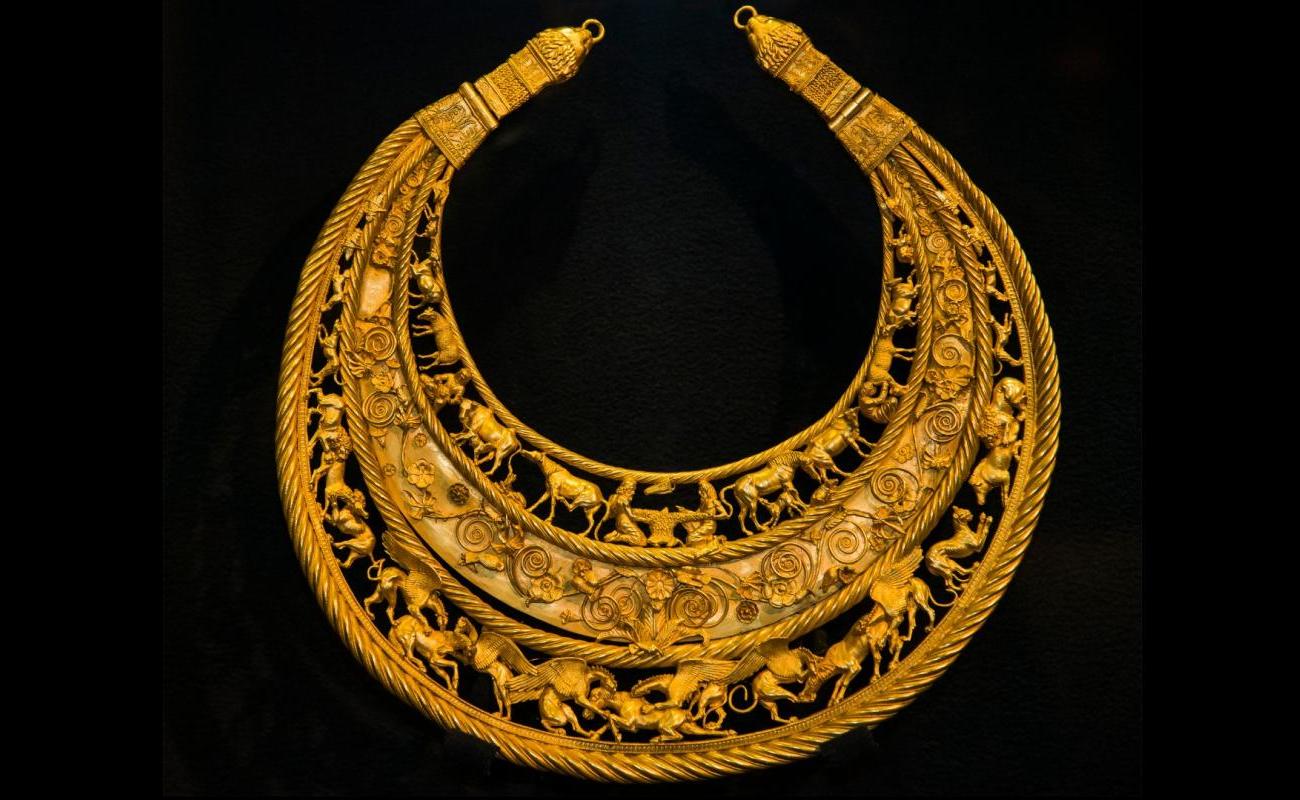‘Ukraine’s heritage is under direct attack’: why Russia is looting the country’s museums

As Russia’s invasion of Ukraine began, the director of the Museum of Local History in Melitopol in the south-east of the country, Leila Ibrahimova, arranged for a hoard of gold artefacts from ancient Scythia to be hidden. Just a few weeks later, she was kidnapped and interrogated by Russian troops. They demanded to know where the Scythian gold was; she refused to cooperate. Subsequently the museum’s curator Galina Andriivna Kucher was taken at gunpoint to the museum and asked to show a Russian “expert” and agents where the gold was. She also refused to locate the collection. Kucher was later abducted from her home on 30 April and her whereabouts remains unknown.
According to a report on the theft in the New York Times, Russian troops eventually found the gold hoard, which dates back to the fourth century BC, boxed up in the museum’s basement. The items were taken to Donetsk, in the Russian-controlled Donbas region, for “safety”, with the museum’s newly installed puppet director, Evgeny Gorlachev, stating that the gold artefacts were not just for Ukrainians but “of great cultural value for the entire former Soviet Union”. His carefully chosen words were designed to erase the collection’s Ukrainian heritage and replace it with a Soviet one, one that suggested Ukraine was back within Russia’s sphere of influence and control.
To date, Russian forces have caused the destruction or severe damage of 250 museums and institutions in Ukraine. Twenty-five paintings by Ukrainian folk artist Maria Prymachenko were incinerated after the Museum of Local History in Ivankiv was hit by a missile. The Arkhip Kuindzhi museum in the besieged city of Mariupol was badly damaged by an airstrike that left paintings exposed to the elements, hanging on walls amid piles of rubble. The Cultural Heritage Monitoring Lab, run by the Virginia Museum of Natural History in association with the Smithsonian, has already logged more than 110 memorials destroyed by Russian weapons. But as well as destroying museums and galleries, Russian troops are accused of having stolen an estimated 2,000 artworks. In addition to the theft of the Scythian gold in Melitopol, in Mariupol a handwritten Torah scroll and a valuable gospel printed in Venice in 1811 were all have been taken.
Autocratic leaders seizing art as a means to rewriting a nation’s cultural history and advance their interests is nothing new: in 1937, Hitler confiscated 17,000 works of art from more than 100 German museums in less than a month. Some were shown in his Degenerate Art exhibition but many were destroyed or “lost”. Napoleon had cartloads of masterpieces shipped to Paris from all over Europe: the classical sculptures Apollo Belvedere and Laocoön from Italy; Rubens’s The Descent from the Cross from Belgium. But these latest thefts are in keeping with Putin’s attempts to erase Ukraine’s independent history and promote his own expansionist model of a new Russian empire.
It is clear that Putin sees the Scythian gold as particularly central to Ukraine’s cultural identity and independence. It is not the first time he has tried to claim it for Russia. In 2014, examples of Scythian gold were on loan to the Allard Pierson museum in Amsterdam. Four of the Ukrainian museums that had issued the loans were in Crimea. As Putin invaded and annexed Crimea, he pressed the Netherlands to send the gold back. A protracted legal battle ensued and only in October 2021 did a judge finally rule that the works categorically belonged to the State Museum Fund of Ukraine and not the Russian-controlled Crimean museums (the works remain in the Dutch museum’s stores).
When the paintings that were forcibly removed from Mariupol are also considered, a clear pattern emerges. These works have been chosen to undermine Ukraine’s national identity. Paintings by western European artists have not been targeted, for example. Instead it is the work of Ukrainian-Russian artists that has been stolen. Take 19th-century maritime painter Ivan Aivazovsky. Born in Feodosiya, a Crimean port, he was a leading Romantic artist who painted heavy seas, golden sunsets and storm-tossed ships. The slightly younger Arkhip Kuindzhi, another whose works were taken, was born in Mariupol. His paintings are the calm before Aivazovsky’s storm: landscapes of harmonious tranquillity. Both painters worked in regions that are now in modern-day Ukraine and Russia, and both countries claim the artists as their own. Other works stolen are by Tetyana Yablonska (1917–2005), a politically active Ukrainian painter who was born in Smolensk, Russia, and Mykola Hlushchenko (1901–1977), who lived in Donetsk from an early age but was likewise born in Russia. Russia’s line of thinking seems to be that if it seizes such paintings by Ukrainian-Russian artists then the contested territory they once called home will follow.
There is hope, however. The resilience Ukraine is showing in the war is mirrored by the country’s response to this parallel attack on its culture. At the Venice Biennale, the exhibition This Is Ukraine was crowded with artists, with President Zelenskiy’s handwritten slogan “We are defending our freedom” adorning the side of the building. One of the artists involved, Nikita Kadan, created a work from war-damaged metal shards collected from Donbas during the war of 2014 and the current onslaught. He uses his Instagram account to record damage to Ukrainian museums but also to show how the country is protecting its cultural assets, posting photographs of monuments across the country, wrapped in blankets and tape or surrounded by hundreds of sandbags. All Ukrainians are aware that their heritage is under direct attack.
